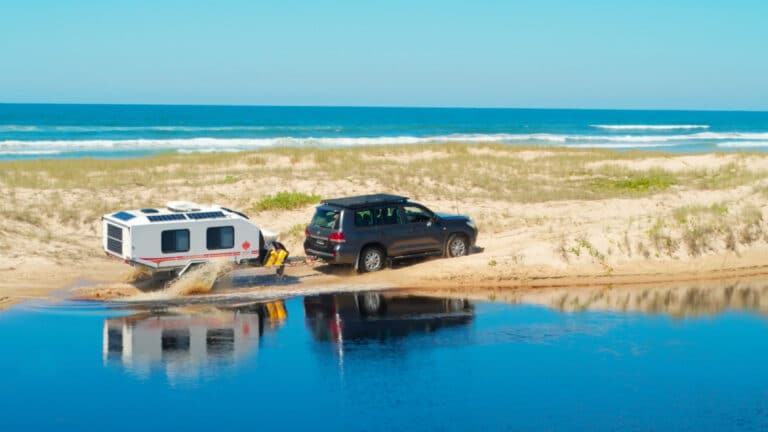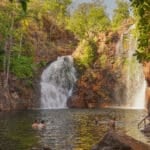By Time Scott, Sam Rees-Jones
Ford’s new Transit is something of a lone shark, yes that’s the right spelling, in that it is a manual-only transmission in a field of autos and semi-autos that help haul the nation’s motorised RVs. It has six speeds, with smooth operation and with the 2.2-litre turbo-diesel in this variant provides efficient carriage. I can’t say that I am a fan of the grille that on Ford’s range of passenger cars reminds me of an Aston Martin but stretched on Transit’s leading edge suggests basking whale shark. Still, if it manages to make similarly effortless progress with meagre fuel economy then that can be overlooked.
Obviously the focus (not a Ford reference) of this test is the Lance Campers 855S slide-on unit that the Transit is carrying. Lance is well-known for the larger slide-ons it imports from the US that are borne by the Dodge Rams converted by Lance (or Trucks n Toys the owning Davis’ family’s linked import venture) but the company wanted to showcase the 855S that can be carried by vehicles like the Transit and Aussie one-tonne utes such as a Mazda BT-50 (although some will require a lazy axle conversion). Given that the 855S is a four-berth camper, use of the dual-cab Transit with roomy accommodation and work-day practicality makes sense in more than simply holiday situations.
The most obvious advantage to a slide-on is the flexibility they add to your travelling options. Being able to remove and ‘park’ your camper body leaves your vehicle free for you to explore unencumbered – this is especially relevant if you have a four-wheel drive. Additional plusses are that a slide-on allows you to tow a trailer, with a boat, for example and your camper doesn’t incur separate registration costs, unlike a caravan. The camper body is secured to the tray using Torklift Turnbuckle restraints. On this Transit variant, where the steel storage boxes are extra features for the camper body, the turnbuckles are within the boxes.
Taking the camper on and off the transport vehicle is straightforward. The Atwood electric, telescopic jack legs operate via remote control and can be individually set for height (there is a manual override, too). Once you’re happy with their positon they can be pegged down. Plastic ‘feet’ can be placed under the base for spreading the load on soft ground. Obviously you’ll need someone to guide you (especially for reloading) but once the camper is unbuckled and raised, you unplug the wiring harness and can drive the vehicle clear. Finally you can use the remote to lower the jacks and bring the camper down to ground level. The lower the final height the greater the stability.
Of course, you can fully utilise the camper without removing it from the vehicle, and grab handles are fitted to the rear wall to aid the climb using the fold-down step. A Carefree rollout awning (if optioned) can be deployed from the rear wall and uses upper and lower telescopic arms, which is easier as a two-person job.
Thoughtfully, as the entry height is going to be varied, the switches for exterior lights and the manual override for the jacks (and the slide-out) are just inside the door on the base of the dinette seats and can be reached from the ground while the camper is still loaded. The entry door itself is a two-piece, with a screen door that in the optional RV Lock door fitting can be PIN locked for security while you’re away from your mobile home.
The dinette slide-out is to the right as you step inside and is activated by the remote control. Lift the seat base cushions out of the way and the table can be lowered to form a base for a double bed. The reversible cushions – to show vinyl trimmed or all fabric faces – are then arranged to form the mattress. In dining mode the area seats four. There is sliding window with insect mesh and a fabric shade and a blind is mounted beneath a curtain pelmet. There are two 12V LED dimmable lights above the dinette while beneath the seats are large pull-out drawers to the interior – dividers section storage bins that are accessible from lockable doors on the outside wall. The trim in the 855S matches the brown hues used throughout on the light ply timber with touches of grey accented in areas such as the kitchen worktop.
Just inside the door is one of two ceiling vents. The one above the forward bed is a simple manual affair but the rear is a switchable 12V electric fan designed to draw warm air in from outside or expel it from a hot camper.
The camper is formed from an aluminium frame for the wall, floor, bed and ceiling that’s block foam insulated. Everything is contained in a laminated TPO (Thermoplastic polyolefin) skin with the interior walls made from Azdel, which is a insulating and sound deadening material that’s rot resistant and most importantly in this application light and strong.
Given that US campers are likely to experience far greater climatic extremes than Australian ones, Lance has subjected them to Alaskan conditions and insulated them accordingly. If you specify the All Weather Package this adds insulation to the battery and gas compartments and all hatch covers and under the bed. The optional ducted diesel or gas heating system directs warm air to the underbody area to make sure the water tanks and valves will all function in extreme cold. With the interior cabin vents for the heating system placed in upper and at floor level positions it means the airflow is such that the thermostat reacts consistently to the interior temperature and is not constantly switching on and off.
House battery power is provided by two 100 AH AGM batteries that in standard form are managed by a CTEK battery charger. For the 855S two 150-amp solar panels can be optioned and managed by a Redarc Battery Management System. Opposite the dinette, behind a sliding timber door is the bathroom/toilet. It’s an all-in one unit, in that the whole room is lined to be the shower cubicle. It has a vent for the ducted heating system and an opaque acrylic skylight and a ceiling vent. There is also a removable clothes rod for the ceiling that can be used to hang dripping wet clothes or outdoor gear and dried with the aid of the heating system. A three-shelf mirror door bathroom cabinet, dry cubby for the loo roll and a ceiling light complete the bathroom. It’s an adequate, light space given the camper dimensions. One stand out is that the elevated position of drains for the water tanks means that they flow straight down into a dump point.
While the heater can be a diesel or gas system it’s a gas-only option for the three-burner cooker in the kitchen that’s next on the nearside – separated by a timber clothes hanging space and two drawer stack from the bathroom – there’s also an oven. A Sphere microwave lives above the rangehood. The galley wall is protected by a chrome effect splashback that extends to the sliding window behind the twin sinks. These sinks have a mixer tap that extends on a flexible hose and a chopping/prep board can be slotted into place over the sinks. The folding glass lid on the cooker extends the preparation area. Facing you above the sink area is a single cupboard, two 240V outlets and the monitor for battery and all water tank levels and the switch for the water pump and heater. There is a two-shelf cupboard under the sink, triangulated to cater for the step to the bedroom to its right.
The step to the bedroom is carpeted and lifts to reveal the battery compartment, wiring and has the fuse panel on the outward face of the step. All electric fittings and fixtures such as the NovaKool (or Waeco) fridges are sourced and installed in Australia.
The bedroom is separated from the living area by a curtain when privacy is required and is well lit by a generous skylight and windows either side of the bed. On the nearside there is a bedside shelf with a laminate top and the window doubles as the kick-out emergency exit panel. Opposite, the area beneath the window has been devoted to a horizontal cupboard with lift up door, while a wardrobe fills the rest of the wall to the bulkhead with the fridge. Opposite the wardrobe is the Jensen entertainment system and the TV/DVD (on an adjustable arm to be viewable form dining- or bedroom). The test camper was also fitted with a Satking satellite system.
Verdict
Opting for a larger US slide-on demands more thought about vehicle choice than simple motive power. But with the 855S (and its smaller brother the 650) you have the option for local offerings as well as the US super utes. There’s no doubt that a slide-on unit affords you huge flexibility and the 855S we sampled is a well-executed, spacious and strong camper. Ventilation and natural light are well served and with the addition of the heating and All Weather Package insulation you’re set to travel anywhere. Australian equipment installations and a great relationship between the US manufacturer and Aussie distributor means complete peace-of-mind.
Pros
- Design flexibility
- Roof vents/access
- Bathroom
Cons
- Minor trim/cabling tidying
- Some flyscreens
- Wood colours won’t suit all
Specifications
Model: Lance 855S slide-on
Dry weight: 1290kg
Wet weight: 1575kg
External length: 5.5m (18ft)
External width: 2.44m (8ft)
External height: 2.67m (8ft, 9in)
Internal height: 2.06m (6ft, 7in)
Price: $69,900 camper as tested $139,900 complete with Ford Transit












